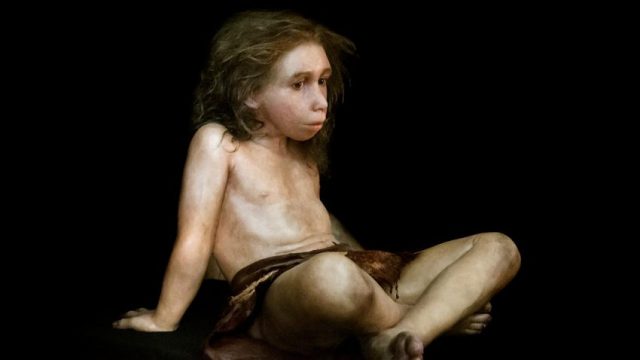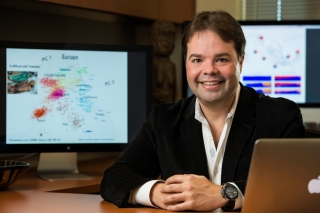Lost Y chromosome
Neanderthals (Homo neanderthalensis) were a species –some say a subspecies although most authors consider there is enough evidence to consider them as a separate species– of human closely related to us. They were firstly discovered in a cave in the Neander Valley («Tal» in German), about 12 km east of Düsseldorf. There is a coincidence of 99.5% in the DNA sequence between them and us. They became extinct between 40,000-28,000 years ago.

The Neanderthal Genome Project found that they contributed to the DNA of modern humans, except most Africans. Modern humans and Neanderthals diverged some 590,000 years ago but they coexisted in the same geographic region for thousands of years and it is considered that both groups interbred during at least three periods beginning 100,000 years ago. The first encounter happened when the common ancestor of all non-Africans interbred with Neanderthals. The second occurred among the ancestors of East Asians and Europeans after the ancestors of Melanesians split off. Later, the ancestors of East Asians –but not Europeans– interbred a third time with Neanderthals. 1
A hybrid progeny is the best explanation for the coincidences between the DNA of different modern populations and those from Neanderthals. Living Asians and Europeans have inherited 1% to 3% of their DNA from Neanderthals that paired with our ancestors 2. The interbreeding may have given modern humans genes that bolstered immunity to pathogens and have been linked to traits such as skin color, fertility and even depression and addiction. To date, five Neanderthal individuals have been whole-genome sequenced, but all were female. The Y chromosome is one of two human sex chromosomes. Unlike the X chromosome, the Y chromosome is passed exclusively from father to son.

A recent article by a research group from Stanford University School of Medicine has examined the Y chromosome of a Neanderthal male from El Sidrón Cave (Asturias, Spain) 3. Archeologists have recovered there the remains of at least 12 individuals: three men, three adolescent boys, three women, and three infants with excellent DNA conservation. This is the first characterization of Neanderthal Y-chromosome sequences.
This Neanderthal male lived in El Sidrón 49,000 years ago and the study demonstrates that the DNA on the Y chromosome has not been passed onto modern humans, i.e. the chromosome has gone extinct seemingly without leaving any trace in modern Homo sapiens populations. The authors have compared their sequences to the human and chimpanzee reference sequences and to the sequences of two Mbo individuals who carry the A00 haplogroup, the most deeply branching group known.
This study supports the idea that modern human women and Neanderthal men were not fully compatible and that Homo neanderthalensis males may have had problems with their fertility in mixed pairings. The new study proposes a mechanism based on DNA evidence: The El Sidrón Neanderthal individual had potentially damaging mutations in four genes: PCDH11Y, TMSB4Y, USP9Y, and KDM5D. Three mutations –within PCDH11Y, USP9Y, and TMSB4Y –are unique to the Neanderthal lineage, and one, within KMD5D, is fixed in modern human sequences. All three genes with potentially functional missense differences between the Neanderthal and modern humans sequences produce male-specific minor histocompatibility (H-Y) antigens (H-Y genes), including KDM5D, the first H-Y gene characterized. Interestingly. KDM5D plays a role in cancer suppressionand ithas previously been linked to increased risk of miscarriages as it can elicit an immune response in pregnant mothers. This response would cause a rejection and miscarriage of male fetuses and it could have prevented the passage of Y chromosome down the paternal line to the hybrid sapiens-neanderthalensis children.
Then, although it can be expected that Neanderthal men and modern human women had sex, such as their respective women and men did, their male offspring may not be viable: male fetuses conceived through sex with Neanderthal males would have miscarried, explaining the absence of Neanderthal Y chromosome genes in present-day humans and supporting the hypothesis of genetic incompatibilities between Neanderthals and modern humans. The functional nature of these mutations suggests that Neanderthal Y chromosome sequences may have played a role in barriers to gene flow, but experiments are needed to demonstrate this.
It is unclear whether Neanderthals might have similar problems reproducing among themselves, whether the different skeleton structure (Neanderthals had wider hips and bigger skulls than modern humans) may also be involved in problems during childbirth, whether this presumable reproduction problem played a role in keeping the two species separated, and whether it was involved in Neanderthal demise.
References
- Zimmer C (2016) Ancestors of Modern Humans Interbred With Extinct Hominins, Study Finds. The New York Times March 17. ↩
- Gibbons A (2016) Modern human females and male Neandertals had trouble making babies. Here’s why. Science magazine ↩
- Mendez FL, Poznik GD, Castellano S, Bustamante CD (2016) The Divergence of Neandertal and Modern Human Y Chromosomes. Am J Hum Genet 98(4): 728–734. DOI: 10.1016/j.ajhg.2016.02.023 ↩